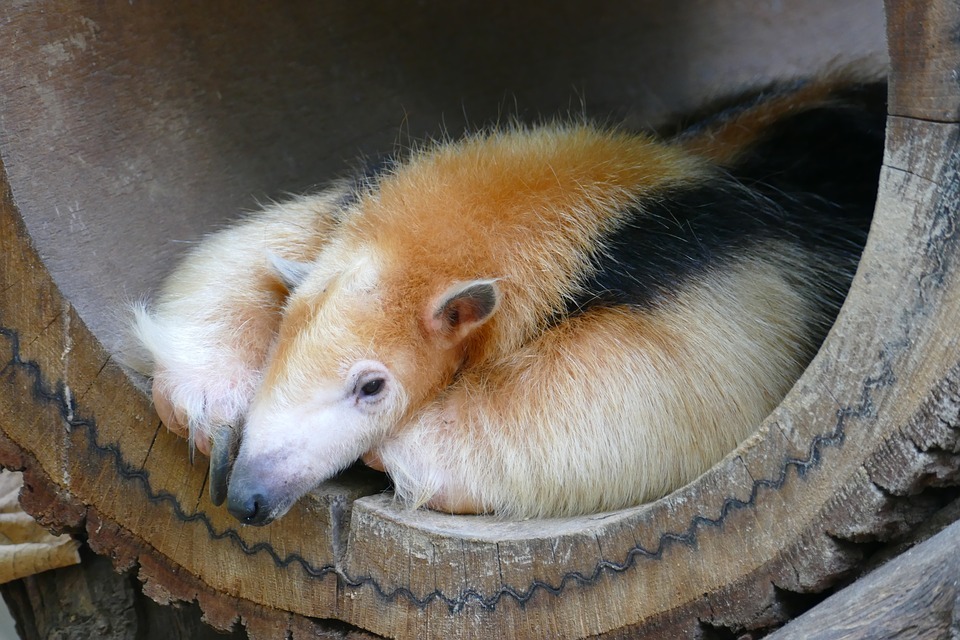Tamanduas are lovely animals, and contrary to how they might look, you might be surprised to find out that they can also be as expressive and loving as dogs. Once you keep Tamanduas as pets, they can be loyal to you, and they will respond when you call out their names. However, they might demand a lot of attention from you. If you’re willing to spend some extra money and you have the patience to provide for their needs, then a Tamandua might be the right pet for you. That’s why we are here to lay down all the things you should know about Tamanduas before you decide to have one as a pet.
The Tamandua’s Behavior and Personality
Tamanduas are native in South America, and they live in trees and on forest floors. Their day in the wild consists of visiting several nests each day in search of insects such as ants and termites. Lesser Tamanduas or tamanduas spend most of their time climbing trees, and their prehensile tails help them move from branch to branch just like a monkey. Their sense of sight might be poor, but they have a perfect sense of hearing and smell.
If they are threatened of attacked, Tamanduas tend to climb a tree and grab onto a branch using their tails and defend themselves using their claws. Tamanduas also give out a stinky liquid that is four times more potent compared to a skunk. They spray this using their anal glands, and it stops the predators in their attacks. Tamanduas also use this smelly liquid to mark their territory.
They are also not very social, and they prefer to live alone without other pets or even Tamanduas. That’s why if you want to adopt a Tamandua, you must purchase a young, hand-raised baby tamandua for it to be able to adapt to humans. However, tamed or domesticated adult Tamanduas can also be a handful because they can damage your furniture, and urinate on your belongings.
Can Tamanduas Live Where You Live?
When they are in the wild, Tamanduas spend most of their time in trees. That’s why if you’re going to have one as a pet, you might need to give them ample climbing spaces such as a sturdy tree or mounted poles. They should be strong enough to hold the tamandua’s weight, and they should be indifferent diameters for the sake of the tamandua’s feet muscles. G
Tamanduas usually have low body temperatures; that’s why their environment should be around room temperature all the time. We suggest that you keep your tamanduas in an enclosure with temperatures of 65 to 85 degrees Fahrenheit. Some fluctuation in the temperatures is okay. However, always keep in mind that tamanduas are not supposed to be exposed to prolonged temperatures that are above 90 degrees Fahrenheit or else they will be at risk for heatstroke. On the other hand, you should not keep it too cold or at temperatures below 65 degrees Fahrenheit because they can become sick, also.
Tamandua’s outdoor enclosure should have space for exploring, climbing, and protection. It should have a hollowed-out tree stump or a house that has heating elements for cold nights. If you allow you tamanduas indoors, make sure that you’re ready to supervise it.
What does Tamanduas Eat?
Just like other exotic pets, tamanduas need a proper diet to maintain their well-being. Tamanduas have very acidic stomachs, they require high-protein foods, and they have no teeth. A lot of zoos offer these kinds of animals with a high-protein insectivore diet that is consists of insects, water, honey, and fruit. You can also add raw meat in their diet to boost proteins, but keep in mind that they don’t have teeth, so only offer soft foods.
Aside from that, we suggest that you allow your anteater to eat the ants that it finds outside and supplement it with purchased ants. You can place the ants on a small branch or in a container that’s filled with dirt or rocks. You can also offer your tamanduas old and rotten logs for them to tear apart during their searching for food.
Common Health Problems of Tamanduas
Having an exotic pet means they also need to have a particular veterinarian. You need to find a veterinarian that is willing to care for your tamandua. This is because they are prone to respiratory diseases, especially if they are exposed to an environment that is too cold or drafty. Lack of humidity can cause your tamandua to develop foot problems. And if you give them inappropriate or insufficient diet, you tamandua can have organ failure.
Buying your Tamandua
You will need a hefty amount of money if you want to own a tamandua. This is because their prices can range from $3,500 to $8,000. Plus, you will need to build them a proper enclosure, feed them the right diet, and have them checked regularly by a veterinarian. If it’s too expensive for you, then we suggest that you should consider adopting them instead. For just $25, you can give this endangered species home and protect them at the same time.
You should consider all the pros and cons before deciding to have a tamandua as a pet. Keep in mind that they require a special diet, they have an unpleasant smell, and that they can be challenging to find.

